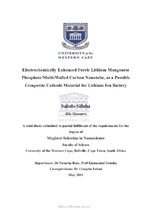Electrochemically enhanced ferric lithium manganese phosphate / multi-walled carbon nanotube, as a possible composite cathode material for lithium ion battery
Abstract
Lithium iron manganese phosphate (LiFe0.5Mn0.5PO4), is a promising, low cost and high energy density (700 Wh/kg) cathode material with high theoretical capacity and high operating voltage of 4.1 V vs. Li/Li+, which falls within the electrochemical stability window of conventional electrolyte solutions. However, a key problem prohibiting it from large scale commercialization is its severe capacity fading during cycling. The improvement of its electrochemical cycling stability is greatly attributed to the suppression of Jahn-Teller distortion at the surface of the LiFe0.5Mn0.5PO4 particles. Nanostructured materials offered advantages of a large surface to volume ratio, efficient electron conducting pathways and facile strain relaxation. The LiFe0.5Mn0.5PO4 nanoparticles were synthesized via a simple-facile microwave method followed by coating with multi-walled carbon nanotubes (MWCNTs) nanoparticles to enhance electrical and thermal conductivity. The pristine LiFe0.5Mn0.5PO4 and LiFe0.5Mn0.5PO4-MWCNTs composite were examined using a combination of spectroscopic and microscopic techniques along with electrochemical techniques such as cyclic voltammetry (CV) and electrochemical impedance spectroscopy (EIS). Microscopic results revealed that the LiFe0.5Mn0.5PO4-MWCNTs composite contains well crystallized particles and regular morphological structures with narrow size distributions. The composite cathode exhibits better reversibility and kinetics than the pristine LiFe0.5Mn0.5PO4 due to the presence of the conductive additives in the LiFe0.5Mn0.5PO4-MWCNTs composite. For the composite cathode, D = 2.0 x 10-9 cm2/s while for pristine LiFe0.5Mn0.5PO4 D = 4.81 x 10-10 cm2/s. The charge capacity and the discharge capacity for LiFe0.5Mn0.5PO4-MWCNTs composite were 259.9 mAh/g and 177.6 mAh/g, respectively, at 0.01 V/s. The corresponding values for pristine LiFe0.5Mn0.5PO4 were 115 mAh/g and 44.75 mAh/g, respectively. This was corroborated by EIS measurements. LiFe0.5Mn0.5PO4-MWCNTs composite showed to have better conductivity which corresponded to faster electron transfer and therefore better electrochemical performance than pristine LiFe0.5Mn0.5PO4. The composite cathode material (LiFe0.5Mn0.5PO4-MWCNTs) with improved electronic conductivity holds great promise for enhancing electrochemical performances and the suppression of the reductive decomposition of the electrolyte solution on the LiFe0.5Mn0.5PO4 surface. This study proposes an easy to scale-up and cost-effective technique for producing novel high-performance nanostructured LiFe0.5Mn0.5PO4 nano-powder cathode material.

